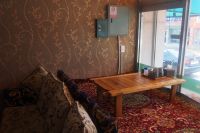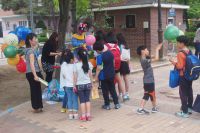[HanCinema's Korea Diaries] "Nonsan" May 26th-28th
 By William Schwartz | Published on
By William Schwartz | Published on
And so, down to Nonsan, a location reknowned for...well, not much actually. Farm fields about, even in the city, because that's the main purpose of rural districts like this. They make food. Here's a more close-up look.
Advertisement
All things considered it's a pretty good use of wide open spce, albeit a somewhat dull one. Way back during the Japanese Occupation, this aspect made Nonsan a useful link for the greater rail system. Being such an isolated location many fixtures from that time still survive. Like this water tower.
It's a pretty cool looking water tower after- granite and all, and I can see how it managed to stay in use for sixty years. Presumably that's how long it took for someone to get around to finding a new way to cool down those hot train engines. But I didn't come to Nonsan for railroad history. There's this interesting (and rather difficult to get to site) called the Baekje Military Museum (백제군사박문관).
The Baekje Military Museum consists of a single major museum hall where artifacts and dioramas abound. These are the first three stages involved in the process of making a sword. Basically any kind of procedure that has some sort of relationship to war is given in-depth explanation at the Baekje Military Museum. Unfortunately, these explanations are pretty much exclusively in Korean.
The outside displays are a bit more interesting, mainly in that they're larger and more attuned to the visual rather than the educational element. It's weird to think of horses wearing armor, although in a military context the protection almost certainly outweighs the discomfort to the horse.
This even goes so far as to tanks, which as far as I know were not used by Baekje. These may not be replicas. I could easily see the Museum receiving old tanks as a donation and then they stick them off to the side somewhere because who would do something as crazy as turn down free tanks?
For all that, the real star of the show is General Gyebaek, a Baekje figure who has been immortalized for conducting a courageous last stand against vastly numerically superior Silla forces with only five thousand men. Personally I find it a little odd that a man who fought against the unification of the three kingdoms is so well known, but eh, whatever. The Baekje Military Museum appears to have been conceived in large part as a memorial park to the man. Oddly enough no mention is made of Lee Seo-jin or the drama "Gyebaek". Probably because locally the man's more of a hero among history buffs than drama fans.
In other military history points, there was, of course, a statue of Lee Soon-shin in the main city. He has no relationship to Nonsan that I know of. It's just that everyone loves the guy, you know?
In culinary matters I found this neat Uzbek restaurant run by actual Uzbeks. I always find it comforting to meet foreigners who can't speak English. They're the ones who put a real effort into fitting in around Korea. Also their superior command of the Korean language inspires me to do better.

This is Kuchibara (쿠치바라). I'm not actually all that sure what Kuchibara is, or even if it's real Uzbek cuisine. That's just the name the dish had on the menu. It looked like dumplings and vegetables served in hot soup-exactly the kind of food that would make me feel better after being sick, and so it did. The tea helped, too.
Overall I really just liked the feel of this place. Couches and carpets- all so very comfortable, and not at all what I'm used to in restaurants, where I'm normally forced to sit in a chair. People are always surprised when I request to sit on the floor when it's available. I don't know why.
There was of course Korean food too- these are Party Noodles (잔치국수), which I've noticed are available nearly everywhere for cheap in the central portion of Korea. Never did notice it up north. How mysterious- and delicious.
Article by William Schwartz
 William Schwartz
William Schwartz
Staff writer. Has been writing articles for HanCinema since 2012, having lived in South Korea from 2011 to 2021. He is currently located in the Portland metropolitan area. William Schwartz can be contacted via william@hancinema.net, and is open to requests for content in future articles.




















